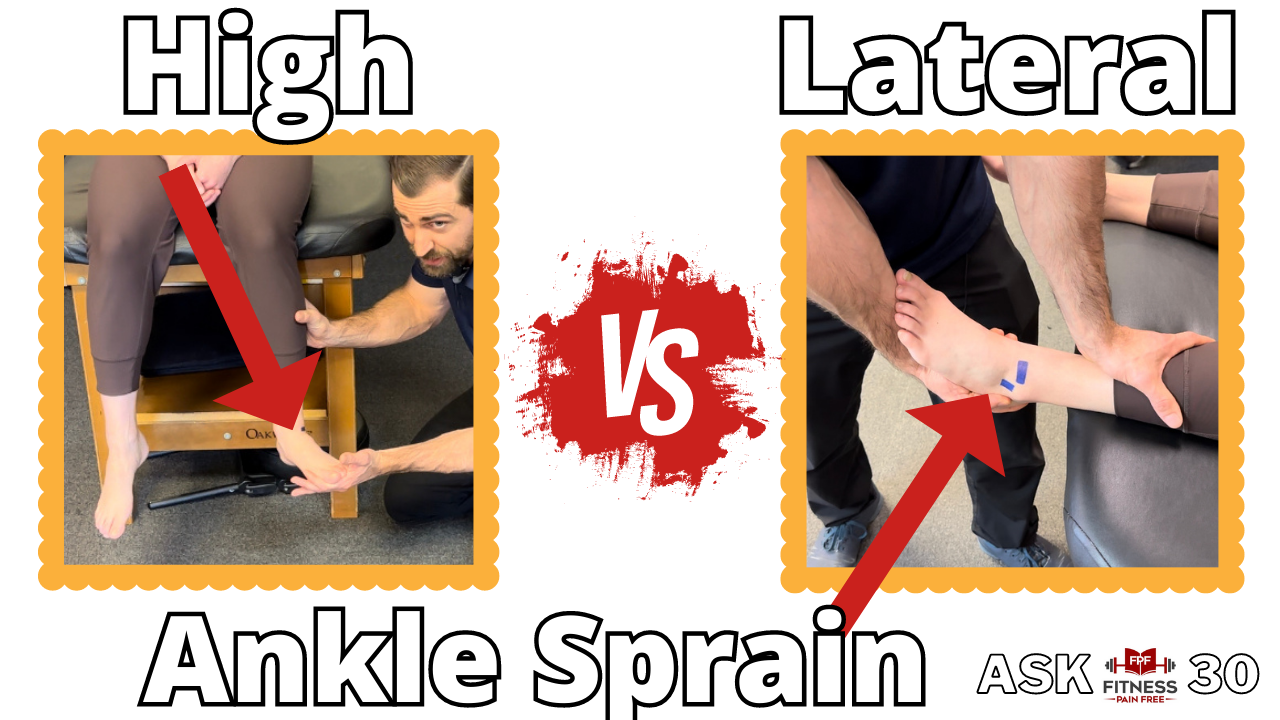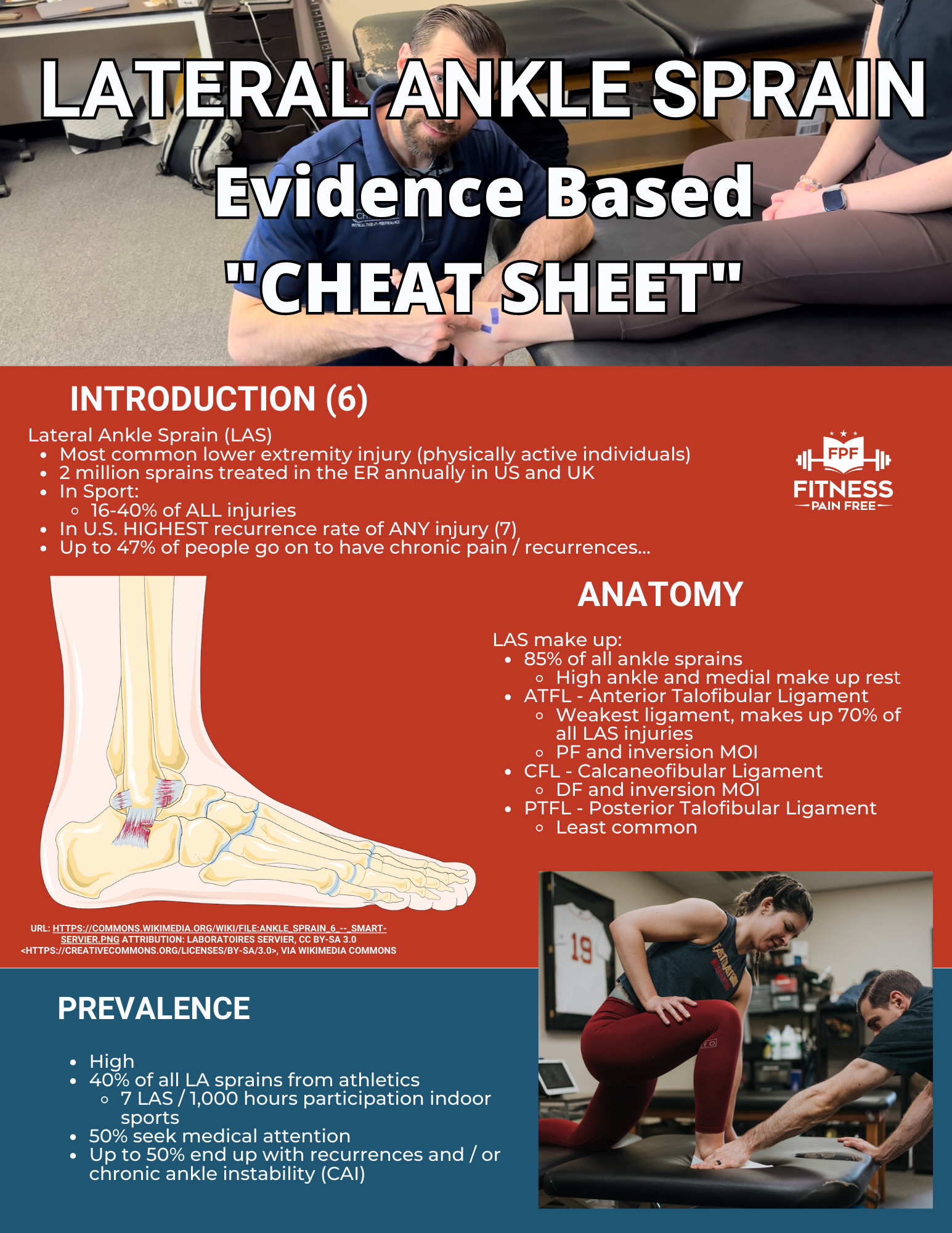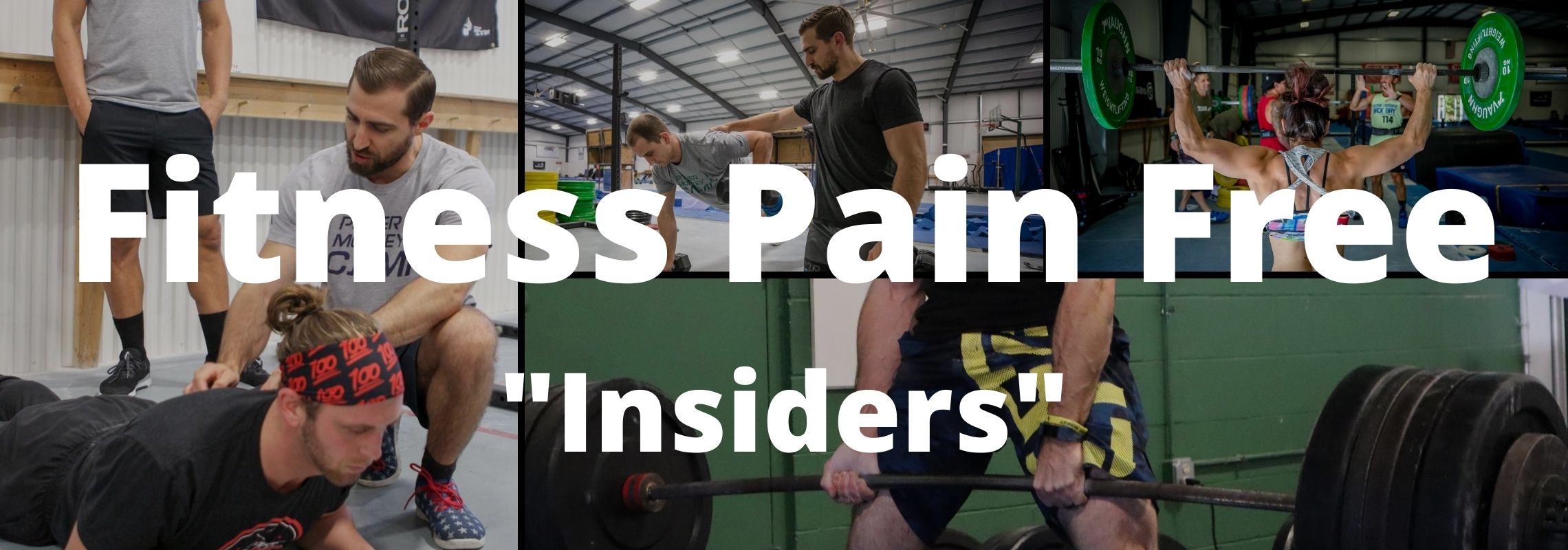
Lateral vs. High Ankle Sprains - What Physical Therapists NEED to Know | Ask FPF Episode 30
To go along with today's episode I have a nice infographic to share...
Evidence Based Lateral Ankle Sprain "Cheat Sheet" for Clinicians
Click HERE to download it for FREE:
Click HERE to Download FREE
Grab the rest of the Mini Course and Sign up for the Certification Pre-sale list:
- FPF Mini Course - 7 Reasons Why Injuries Happen in the Gym and What to do About it
- The Fitness Pain Free Certification
In today's episode we go over Lateral vs. High Ankle Sprains - What Physical Therapists NEED to Know | Ask FPF Episode 30:
Welcome to this guide on differentiating between high ankle sprains and lateral ankle sprains. As healthcare professionals, it is crucial for us to accurately diagnose and differentiate between various types of ankle sprains to provide appropriate and effective treatment. This guide aims to enhance your understanding of the key differences between high ankle sprains and lateral ankle sprains, based on the latest research and evidence.
1: Anatomy and Mechanism of Injury: Understanding the anatomical structures involved and the mechanisms of injury is essential in distinguishing between high ankle sprains and lateral ankle sprains.
- Lateral ankle sprains involve damage to the lateral ligaments, including the anterior talofibular ligament (ATFL), calcaneofibular ligament (CFL), and sometimes the posterior talofibular ligament (PTFL). These sprains commonly occur due to inversion and plantarflexion mechanisms.
- High ankle sprains, also known as syndesmotic sprains, involve damage to the syndesmotic ligaments connecting the tibia and fibula, primarily the anterior inferior tibiofibular ligament (AITFL) and interosseous ligament. They often result from external rotation or dorsiflexion forces.
2: Clinical Presentation: Differentiating between high ankle sprains and lateral ankle sprains based on clinical presentation can provide valuable diagnostic information.
- Lateral Ankle Sprains: Patients with lateral ankle sprains typically present with pain, swelling, and tenderness along the lateral aspect of the ankle. They may also experience instability, limited range of motion, and difficulty with weight-bearing.
- High Ankle Sprains: High ankle sprains are characterized by pain and tenderness above the ankle joint, often referred to as the "syndesmotic region." Patients may report pain with rotational movements, as well as difficulty with weight-bearing and walking.
3: Physical Examination and Special Tests: Performing a thorough physical examination, including specific tests, can help differentiate between high ankle sprains and lateral ankle sprains.
- Lateral Ankle Sprains: Special tests for lateral ankle sprains focus on assessing the integrity of the lateral ligaments. These tests may include the anterior drawer test and talar tilt test
- High Ankle Sprains: Specific tests for high ankle sprains concentrate on evaluating the syndesmotic ligaments. The most common tests are the external rotation stress test and the squeeze test at the mid-calf.
4: Treatment and Rehabilitation: Differentiating between high ankle sprains and lateral ankle sprains is crucial for developing appropriate treatment and rehabilitation plans.
In today's video we go over how to differentiate between the two and some treatment strategies for each:
I think I have a low ankle sprain!?!
- Dan Pope DPT,OCS,CSCS
Show Notes / Relevant Articles:
Want to support me and decide topics for future episodes? Click HERE to sign up for FPF "Insiders" for just a dollar. You'll gain access to 100+ webinars, e-books and complete guides. Plus, you'll get private access to the "Insiders" Facebook group where you can have all of your questions answered by me.
Looking for other ways to support me that are 100% free?
- Like, comment and share on youtube, facebook and instagram
- Leave a 5-star review on apple podcasts
Thank you!
Dan Pope DPT, OCS, CSCS
References:
DeFroda SF, Bodendorfer BM, Hartnett DA, Milner JD, Yang DS, Silber ZS, Forsythe B. Defining the contemporary epidemiology and return to play for high ankle sprains in the National Football League. Phys Sportsmed. 2022 Aug;50(4):301-305. doi: 10.1080/00913847.2021.1924046. Epub 2021 May 11. PMID: 33906554.
Vuurberg G, Hoorntje A, Wink LM, et al. Br J Sports Med 2018
van Middelkoop M, van Rijn RM, Verhaar JA, Koes BW, Bierma-Zeinstra SM. Re-sprains during the first 3 months after initial ankle sprain are related to incomplete recovery: an observational study. J Physiother. 2012;58(3):181-8. doi: 10.1016/S1836-9553(12)70109-1. PMID: 22884185.
Kemler E, Thijs KM, Badenbroek I, van de Port IG, Hoes AW, Backx FJ. Long-term prognosis of acute lateral ankle ligamentous sprains: high incidence of recurrences and residual symptoms. Fam Pract. 2016 Dec;33(6):596-600. doi: 10.1093/fampra/cmw076. Epub 2016 Aug 17. PMID: 27535328.
Bendahou M, Khiami F, Saïdi K, Blanchard C, Scepi M, Riou B, Besch S, Hausfater P. Compression stockings in ankle sprain: a multicenter randomized study. Am J Emerg Med. 2014 Sep;32(9):1005-10. doi: 10.1016/j.ajem.2014.05.054. Epub 2014 Jun 12. PMID: 25043629.
Link: https://www.jospt.org/doi/10.2519/jospt.2013.4792 Cleland JA, Mintken PE, McDevitt A, Bieniek ML, Carpenter KJ, Kulp K, Whitman JM. Manual physical therapy and exercise versus supervised home exercise in the management of patients with inversion ankle sprain: a multicenter randomized clinical trial. J Orthop Sports Phys Ther. 2013;43(7):443-55. doi: 10.2519/jospt.2013.4792. Epub 2013 Apr 29. PMID: 23628755.
Halabchi F, Hassabi M. Acute ankle sprain in athletes: Clinical aspects and algorithmic approach. World J Orthop. 2020 Dec 18;11(12):534-558. doi: 10.5312/wjo.v11.i12.534. PMID: 33362991; PMCID: PMC7745493.
Wagemans J, Bleakley C, Taeymans J, Schurz AP, Kuppens K, Baur H, Vissers D. Exercise-based rehabilitation reduces reinjury following acute lateral ankle sprain: A systematic review update with meta-analysis. PLoS One. 2022 Feb 8;17(2):e0262023. doi: 10.1371/journal.pone.0262023. PMID: 35134061; PMCID: PMC8824326.
Smith MD, Vicenzino B, Bahr R, Bandholm T, Cooke R, Mendonça LM, Fourchet F, Glasgow P, Gribble PA, Herrington L, Hiller CE, Lee SY, Macaluso A, Meeusen R, Owoeye OBA, Reid D, Tassignon B, Terada M, Thorborg K, Verhagen E, Verschueren J, Wang D, Whiteley R, Wikstrom EA, Delahunt E. Return to sport decisions after an acute lateral ankle sprain injury: introducing the PAASS framework-an international multidisciplinary consensus. Br J Sports Med. 2021 Nov;55(22):1270-1276. doi: 10.1136/bjsports-2021-104087. Epub 2021 Jun 22. PMID: 34158354.
Melanson SW, Shuman VL. Acute Ankle Sprain. [Updated 2022 May 29]. In: StatPearls [Internet]. Treasure Island (FL): StatPearls Publishing; 2023 Jan-. Available from: https://www.ncbi.nlm.nih.gov/books/NBK459212/
Longo UG, Loppini M, Romeo G, van Dijk CN, Maffulli N, Denaro V. Bone bruises associated with acute ankle ligament injury: do they need treatment? Knee Surg Sports Traumatol Arthrosc. 2013 Jun;21(6):1261-8. doi: 10.1007/s00167-013-2383-5. Epub 2013 Jan 19. PMID: 23334625.
Roos KG, Kerr ZY, Mauntel TC, Djoko A, Dompier TP, Wikstrom EA. The Epidemiology of Lateral Ligament Complex Ankle Sprains in National Collegiate Athletic Association Sports. Am J Sports Med. 2017 Jan;45(1):201-209. doi: 10.1177/0363546516660980. Epub 2016 Oct 1. PMID: 27573356.
Ankle Sprain Image:
URL: https://commons.wikimedia.org/wiki/File:Ankle_sprain_6_--_Smart-Servier.png
Attribution: Laboratoires Servier, CC BY-SA 3.0 <https://creativecommons.org/licenses/by-sa/3.0>, via Wikimedia Commons
Johannsen, A. 1978. Acta Orthopaedica. Radiological diagnosis of lateral ligament lesion of the ankle: a comparison between talar tilt and anterior drawer sign.
Sman AD, Hiller CE, Rae K, Linklater J, Black DA, Nicholson LL, Burns J, Refshauge KM. Diagnostic accuracy of clinical tests for ankle syndesmosis injury. Br J Sports Med. 2015 Mar;49(5):323-9. doi: 10.1136/bjsports-2013-092787. Epub 2013 Nov 19. PMID: 24255766.
Ankle Sprain Image: URL: https://commons.wikimedia.org/wiki/File:Sprained_foot.jpg Attribution: Boldie, Public domain, via Wikimedia Commons
Leong NL, Kator JL, Clemens TL, James A, Enamoto-Iwamoto M, Jiang J. Tendon and Ligament Healing and Current Approaches to Tendon and Ligament Regeneration. J Orthop Res. 2020 Jan;38(1):7-12. doi: 10.1002/jor.24475. Epub 2019 Sep 30. PMID: 31529731; PMCID: PMC7307866.
Mauntel TC, Wikstrom EA, Roos KG, Djoko A, Dompier TP, Kerr ZY. The Epidemiology of High Ankle Sprains in National Collegiate Athletic Association Sports. Am J Sports Med. 2017 Jul;45(9):2156-2163. doi: 10.1177/0363546517701428. Epub 2017 Apr 19. PMID: 28423285.
Liu J, Valentine D, Ebraheim NA. Management of Syndesmosis Injury: A Narrative Review. Orthop Res Rev. 2022 Dec 10;14:471-475. doi: 10.2147/ORR.S340533. PMID: 36530364; PMCID: PMC9749496.
Mann B, Gruber AH, Murphy SP, Docherty CL. The Influence of Ankle Braces on Functional Performance Tests and Ankle Joint Range of Motion. J Sport Rehabil. 2019 Nov 1;28(8):817-823. doi: 10.1123/jsr.2018-0315. PMID: 30300098.

